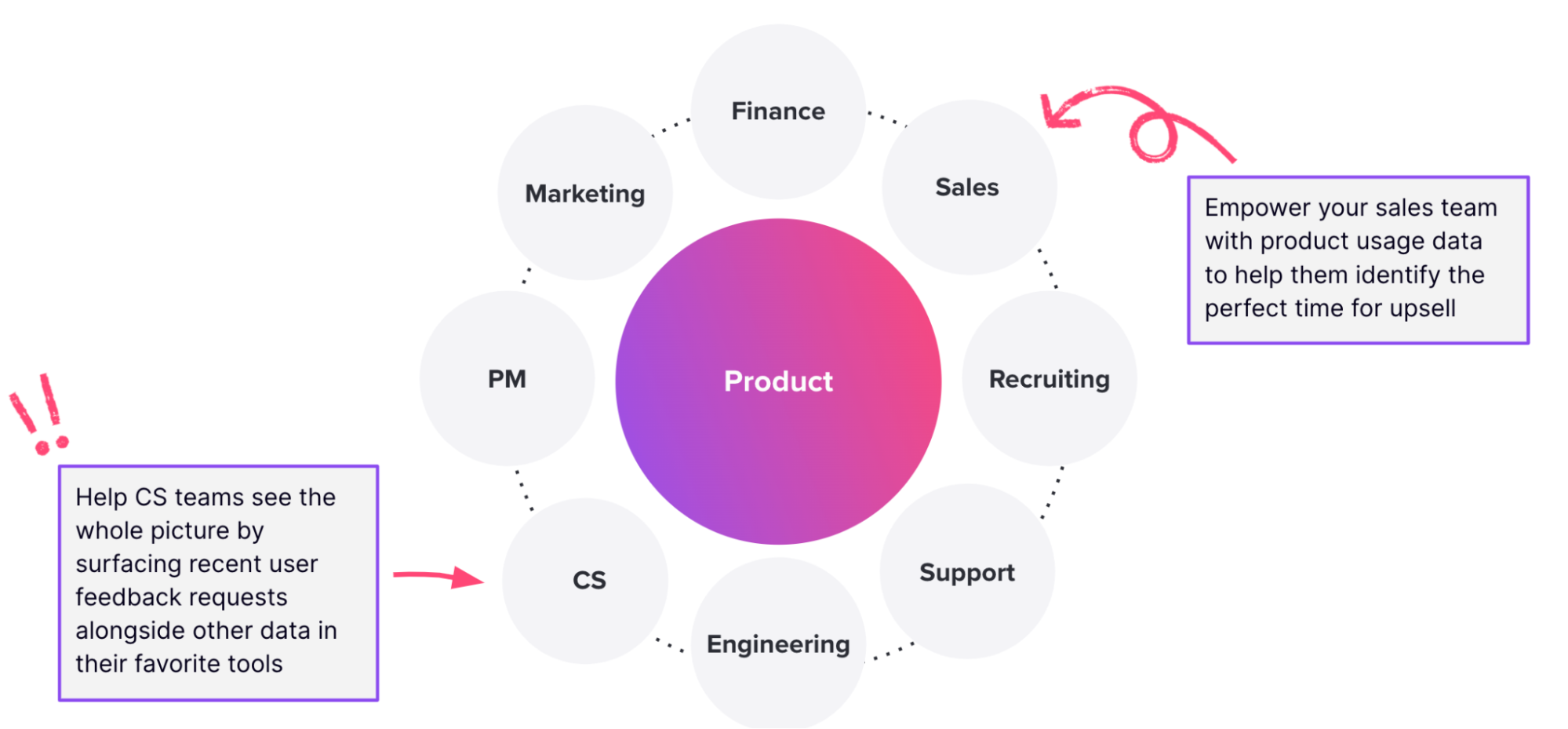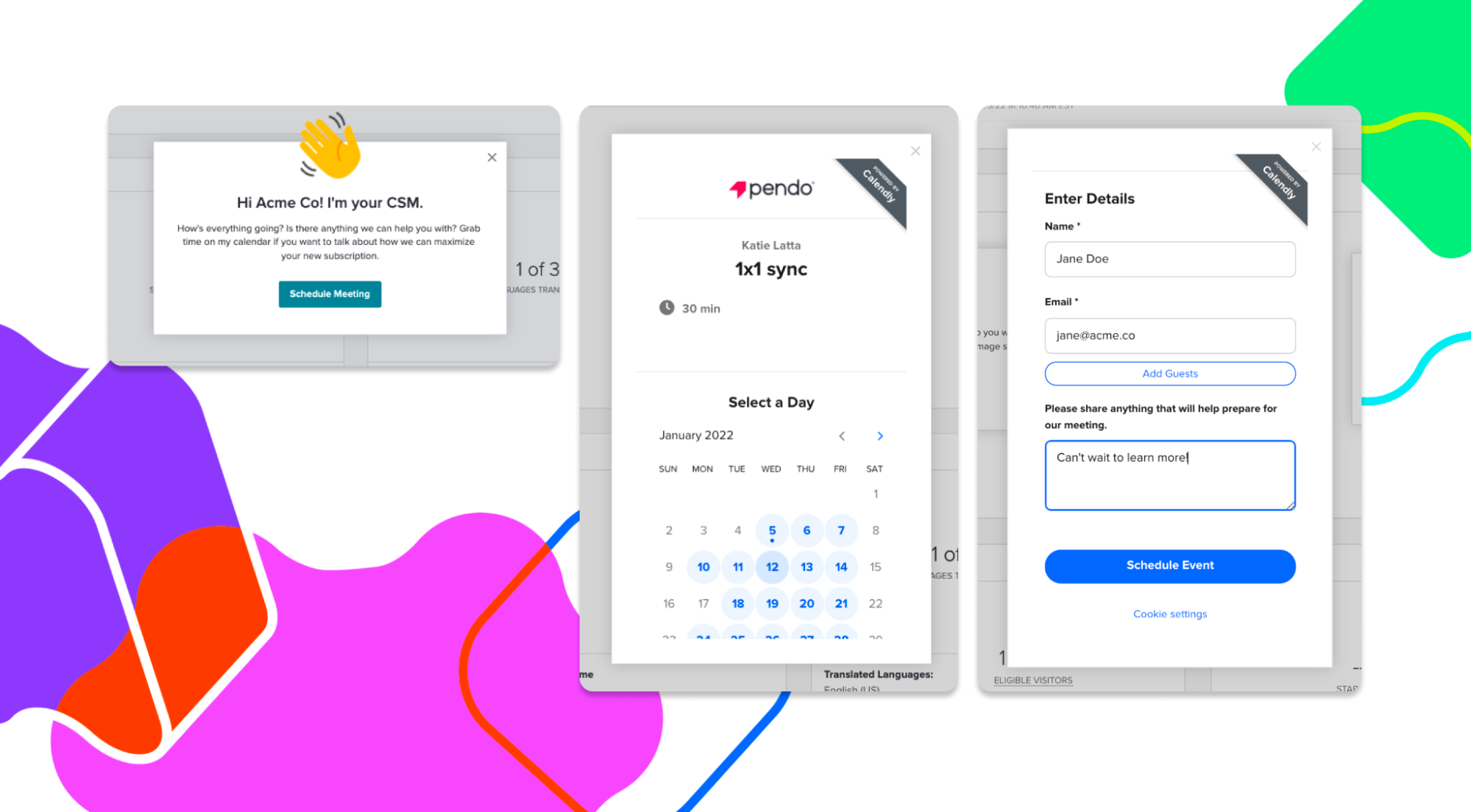At product-led organizations, the product is more than what the company sells. It’s also how teams organize and align, how they communicate with customers, and how they refine their roadmap. The primacy of the product means every team must focus on how they can contribute to a solution that delights users as it helps solve their problems, facilitates interaction, and even provokes sharing with other potential buyers.
In other words, the product is not just one part of the customer experience; it is the experience.
A product-led strategy forces you to increase communication and become closer to your customer. And product usage analytics and customer feedback create a common language between departments and help inform decision-making about what, when, and for whom to build.
Why product-led is more than collecting data
One of the essential ingredients in a product-led organization is product analytics and customer feedback. This powerful data informs your product decisions because it helps you understand how users interact with your products so you can determine how to improve them.
However, collecting this data on its own isn’t enough. In a recent webinar, I sat down with Ellie McCandless (Product Marketing Manager at Pendo) to discuss why:
- Product analytics and feedback data is only as good as the decisions the team makes from them
- A product-led strategy is not something that one person or team can implement on their own
- Truly product-led organizations share data in the places that their teams work
Here are examples and tips on how Pendo Feedback paired with integrations can help you become product-led.
A product-led process for customer feedback
Product managers hear customer feedback all of the time, from both customers themselves and internal teams. It’s a real challenge to be able to understand and process all this data. But a solid process for collecting and using customer feedback is guaranteed to improve your product decisions.
Product-led organizations create Product Feedback Policies, which are short documents that describe where feedback should be submitted, how often the product team reviews it, and how updates are communicated back. Think of this process as similar to how you handle support.
Sharing a documented feedback process with your customers and teams sets expectations and keeps the product team in control. It also means that product teams know exactly where to go to access the customer insights they need.
And remember that you can also use integrations to help you capture feedback in the places your customer-facing teams already work. For example, if you use Pendo Feedback, you can integrate with Zendesk, Salesforce, and Intercom to capture feedback in the tools your teams use everyday.
Closing the loop on customer feedback
Product-led organizations work to enhance the customer experience every step of the way—and feedback is one great way to do this. But collecting customer feedback is only one half of the process. It’s important to communicate back to the people who submit feedback so your teams and customers see their voices being considered in product decisions. An easy way to do this is to talk to your marketing team and review the ways you already communicate with customers. Most organizations have recurring newsletters, webinars, communities, or blogs where you could add product updates. You can also use Pendo Feedback to launch in-app guides or send emails as features that customers care about get released.
Why a product-led strategy has to be a team sport
There’s no use collecting product data if it doesn’t get put to good use across your teams. As part of your product-led strategy, think about how the insights you’re gathering can directly add value to the workflow of your teams. And think about how you might use Pendo’s integrations to share and enhance the data where your teams are already working.
For example, you could empower your sales teams with product usage data to identify upsell opportunities, or to surface a customer’s feedback requests to customer success.
This process will look different in every organization. If you don’t know where to start, talk to your internal teams to identify where they’re experiencing gaps, and learn about how product data can help them. There’s lots of inspiration on Pendo’s integrations page. Simply search for the software you use and check out what’s possible—for example, scaling business processes or reducing support costs.
A product-led integrations example
Just like with customer feedback, sharing other types of product data not only benefits your teams, but improves the customer experience, too. During the webinar, Ellie talked through Pendo’s integration with Calendly as a great use case for customer success teams. With Pendo’s integration, you can embed a scheduling link into in-app guides to quickly and easily schedule calls with specific customers. This is an example of thinking about your customer’s journey from day one and enhancing the touch points they have with your organization, all within your product.
Tips on being truly product led
- Don’t just collect product feedback—centralize all your data
- Centralizing your data creates a library of feedback information for your product teams to access. They will know they are working with high quality information and can pick and choose the data they need based on the products they have on their product roadmap.
- Feedback isn’t just for product managers—it’s a team effort
- Customer-facing teams are a brilliant source of feedback through close connections with prospects and customers. Creating a process around product feedback leads to a better experience for everyone.
- Build based on user feedback and communicate back
- Collecting feedback is only half of the job. Close the loop with teams and customers by sharing how your product teams used their feedback. This creates a flywheel effect by encouraging stakeholders to keep submitting feedback.
- Surface data to teams in the places they’re already working
- The average enterprise business uses 288 different software applications. That’s a lot of tools to manage! Make data actionable by integrating the relevant insights with the tools those teams are already living in every day. This simple step will make their jobs easier, and will ensure that they’re actually making decisions based on valuable product data.
- Don’t hoard product data—empower all teams to act on it
- Product data is only as good as the decisions you make from it. By integrating and creating systems to share product data and feedback, you make it valuable to all teams—not just the product team.
学びを深める
Check out these resources to learn more about how Feedback and Integrations can help power your product-led strategy, or watch the full recording of my conversation with Ellie below.
- Pendo Integrations page
- Create a Product Feedback Policy
- How Pendo’s integrations enable product-led decision making








